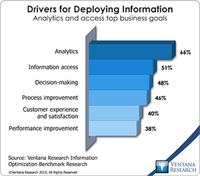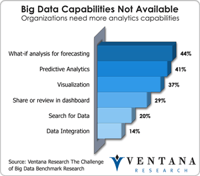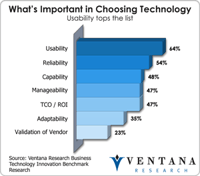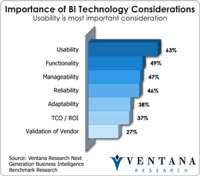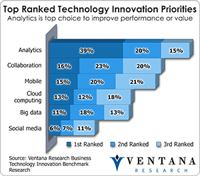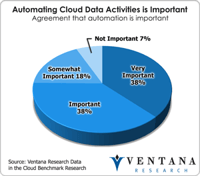I have been meaning to write about Salesforce since its Dreamforce 2015 conference. Salesforce provides a platform, tools and applications for business and IT who claims to be the ‘no software’ company which as you will read is exactly what happened on May 10th. Heck, Salesforce is making a lot of advances on its platform, its applications and even with Analytics and the Internet of Things. These changes are at the center of what at our analyst firm calls digital business innovation. Much of...
Read More
Topics:
Sales,
Salesforce.com,
Marketing,
NA14,
Analytics,
Business Analytics,
Business Collaboration,
Business Mobility,
Cloud Computing,
Customer Service,
IOT,
CRM,
Customer Performance Management (CPM),
Sales Performance Management (SPM)
Data is an essential ingredient for every aspect of business, and those that use it well are likely to gain advantages over competitors that do not. Our benchmark research on information optimization reveals a variety of drivers for deploying information, most commonly analytics, information access, decision-making, process improvements and customer experience and satisfaction. To accomplish any of these purposes requires that data be prepared through a sequence of steps: accessing, searching,...
Read More
Topics:
Big Data,
Predictive Analytics,
Operational Performance Management (OPM),
Analytics,
Business Analytics,
Business Collaboration,
Business Intelligence,
Business Mobility,
Cloud Computing,
Data Preparation,
Location Intelligence,
Operational Intelligence,
Business Performance Management (BPM),
Customer Performance Management (CPM),
Financial Performance Management (FPM),
Information Applications (IA),
Information Management (IM),
Information Optimization,
IT Performance Management (ITPM),
Sales Performance Management (SPM),
Supply Chain Performance Management (SCPM),
Workforce Performance Management (WPM)
Most people in business management admit that sales is more an art than a science. Organizations have long struggled to find the right mix to improve its effectiveness, and few get the most out of available technology. For many the default is still to use sales force automation (SFA) and spreadsheets to manage processes and try to increase the productivity of sales staff. In our view they should take a holistic approach to sales processes from contact to close and support everything from sales...
Read More
Topics:
Sales,
Operational Performance Management (OPM),
Recurring Revenue,
Sales Compensation,
Sales Forecasting,
Business Collaboration,
Business Mobility,
Cloud Computing,
CRM,
Customer Performance Management (CPM),
SFA
In the realm of technology that matters for business and IT, our firm as part of our responsibility continually assesses the latest technology and how it can impact organizations’ efficiency and effectiveness. Our benchmark research in technology innovation found that 87% of participants indicated the importance of increasing the organization’s value through technology innovation. Every year we take our knowledge from research and technology briefings to focus on our Technology Innovation Awards
Read More
Topics:
Big Data,
Datameer,
Mobile,
Sales,
Social Media,
Sustainability,
Customer,
ESRI,
Globoforce,
GRC,
HCM,
Kronos,
Kyriba,
Location Analytics,
Marketing,
NetBase,
Office of Finance,
Operational Performance Management (OPM),
Overall Operational Leadership,
Peoplefluent,
Planview,
SQLstream,
VMWare,
VPI,
IT Analytics & Performance,
Analytics,
Business Analytics,
Business Collaboration,
Business Intelligence,
Business Mobility,
CIO,
Cloud Computing,
Collaboration,
Governance, Risk & Compliance (GRC),
Hortonworks,
IBM,
Informatica,
Information Builders,
Information Management,
Information Technology,
KXEN,
Location Intelligence,
Operational Intelligence,
Oracle,
Business Performance Management (BPM),
Contact Center,
Customer Performance Management (CPM),
Datawatch,
Financial Management,
Financial Performance Management (FPM),
Information Applications (IA),
Information Management (IM),
Information Optimization,
IT Performance Management (ITPM),
Johnson Controls Panoptix,
Roambi,
Sales Performance Management (SPM),
Service & Supply Chain,
Supply Chain Performance Management (SCPM),
Upstream Works,
Vertex,
Workforce Performance Management (WPM),
Xactly
I was recently at Oracle Analyst World which is the vendor’s annual gathering of technology industry analysts. Its executives and others in the products organization deliver the latest news on where the titan is focusing efforts to expand its technology and markets. This year, against the background of the consumer and business markets embracing mobile and cloud computing, Oracle is working to sound like a more friendly supplier that can help remove legacy issues and inefficiencies that plague...
Read More
Topics:
Big Data,
Mobile,
Social Media,
Operational Performance Management (OPM),
Social Collaboration,
Business Analytics,
Business Collaboration,
Business Intelligence,
Business Mobility,
CIO,
Cloud Computing,
Governance, Risk & Compliance (GRC),
Location Intelligence,
Operational Intelligence,
Oracle,
Business Performance Management (BPM),
CFO,
COO,
Customer Performance Management (CPM),
Financial Performance Management (FPM),
Information Applications (IA),
Information Management (IM),
IT Performance Management (ITPM),
Sales Performance Management (SPM),
Supply Chain Performance Management (SCPM),
Workforce Performance Management (WPM)
LucidWorks addresses the growing volume of information now being stored in the enterprise and in big data with two products aimed at the enterprise with search technology. Though you may not be familiar with LucidWorks (previously known as Lucid Imagination), the company has for many years contributed to Apache Lucene, an open source search project, and commercialized and supported for it for business.
Read More
Topics:
Big Data,
MapR,
Business Analytics,
Business Intelligence,
Business Mobility,
Cloud Computing,
Cloudera,
Hortonworks,
Customer Performance Management (CPM),
Information Management (IM),
Sales Performance Management (SPM),
Search,
Workforce Performance Management (WPM),
Strata+Hadoop
Business intelligence software is supposed to help businesses access and analyze data and communicate analytics and metrics. I have witnessed improvements to BI software over the years, from mobile and collaboration to interactive discovery and visualization, and our Value Index for Business Intelligence finds a mature set of technology vendors and products. But even as these products mature in capabilities, the majority lack features that would make them easy to use. Our recent research on ...
Read More
Topics:
Big Data,
Mobile Technology,
Natural Language,
Business Analytics,
Business Collaboration,
Business Intelligence,
Business Mobility,
Cloud Computing,
Governance, Risk & Compliance (GRC),
Location Intelligence,
Operational Intelligence,
Business Performance Management (BPM),
Customer Performance Management (CPM),
Discovery,
Information Management (IM),
Sales Performance Management (SPM),
Supply Chain Performance Management (SCPM),
Workforce Performance Management (WPM)
Read More
Topics:
Social Media,
Human Capital Management,
Kenexa,
Learning,
Performance,
Recruiting,
Smarter Analytics,
Smarter Workforce,
Social Business,
Social Collaboration,
Business Analytics,
Business Collaboration,
Business Mobility,
Cloud Computing,
Governance, Risk & Compliance (GRC),
IBM,
Compensation,
Financial Performance Management (FPM),
Workforce Performance Management (WPM)
Managing the access, storage and use of data effectively can provide businesses a competitive advantage. Last year I outlined what the big deal is in big data, as the initial focus on the volume, velocity and variety of data – what my colleague Tony Cosentino calls the three V’s – is only one small piece of how organizations should evaluate this technology. The more balanced approach is to include what he calls the three W’s – the what, so what and now what, which shifts the focus to an...
Read More
Topics:
Big Data,
Master Data Management,
Predictive Analytics,
MDM,
Business Analytics,
Business Collaboration,
Business Intelligence,
Business Mobility,
CIO,
Cloud Computing,
Data Governance,
Data Integration,
Information Management,
Location Intelligence,
Operational Intelligence,
Information Applications (IA),
Information Management (IM),
Product Information Management,
Sales Performance Management (SPM),
Workforce Performance Management (WPM)
Happy New Year to all my readers and followers. I hope everyone has gotten some rest and is ready for a great 2013. 2012 was a busy year in which we saw a critical inflection point, where an elevated focus on new methods and innovative technological approaches such as big data, business analytics, business and social collaboration, cloud computing, mobile technology and social media become part of the mainstream business and IT dialogue. These technologies are beginning to be part of or...
Read More
Topics:
Big Data,
Social Media,
Sustainability,
Market Research,
Mobile Technology,
Operational Performance Management (OPM),
Social Collaboration,
Business Analytics,
Business Collaboration,
Business Intelligence,
Business Mobility,
CIO,
Cloud Computing,
Governance, Risk & Compliance (GRC),
Location Intelligence,
Operational Intelligence,
Business Performance Management (BPM),
Customer Performance Management (CPM),
Financial Performance Management (FPM),
Information Applications (IA),
Information Management (IM),
IT Performance Management (ITPM),
Sales Performance Management (SPM),
Supply Chain Performance Management (SCPM),
Technology,
Workforce Performance Management (WPM)


